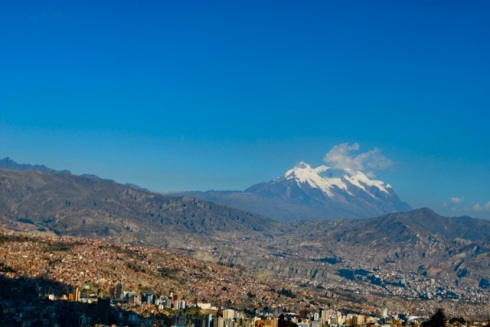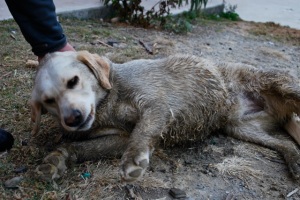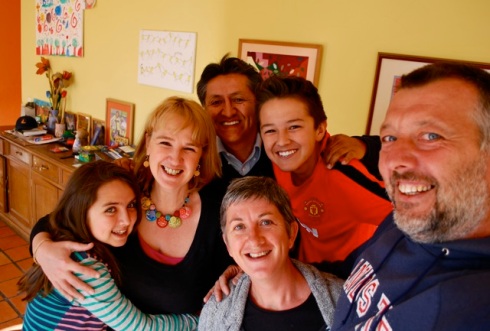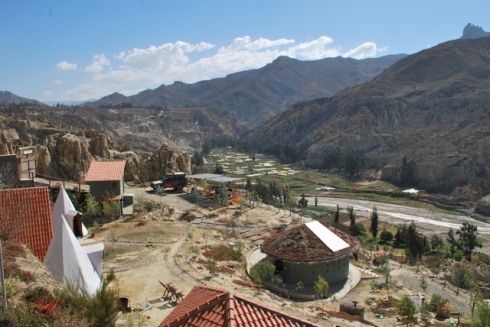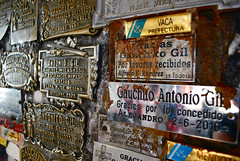By Jeremy
Put a few travellers in a room, add a beer, rum or vino to the equation and talk always turn to it.
Could you live here?
Everyone has had the feeling at some time or another, be it whilst whiling away the days in a hammock on a golden sandy beach, atop a summit in the snow-capped mountains, sitting in a cosy bar in front of a roaring fire or enjoying a perfectly cooked steak in a vine-shaded plaza with a glass of fine – but cheap – red wine.
It’s what makes people buy timeshares or run off with the waiter from the Greek taverna they have known for just a week. Colombia even has a bittersweet slogan for its tourist industry – “the only danger is not leaving” – and they are not talking about the alarmingly high incidence of kidnap or political prisoners.
We’re not immune to the fantasising – sometimes seriously, other times just for fun. We, like our fellow travellers, are always asking the question – could we really live here?
In the 1000-plus days we’ve been on the road there have been contenders – but there’s always a nagging something which makes you think again – the sudden onset of the rainy season, the bureaucracy or simply the local penchant for vallenato or cumbia music at full volume morning, noon and night, all the way through to morning again.
But amongst all the contenders the one that caught us most by surprise is La Paz in Bolivia. On and off, last year and this, we’ve spent almost 6 months living in and around the city. We’ve loved so much of what it has to offer.
And that’s the other thing about travellers – put three of them in a room and you’ll have four different opinions. One person’s paradise is another’s nightmare. So I know there will be plenty of those people who skipped La Paz entirely or briefly passed through it saying…but, what about the cold, the altitude, the occasional smell of urine on a street corner, the traffic, the slow, slow, slow internet, the, the, the….
We recognise all those things but we see so much more in La Paz. That’s why we went back – again.
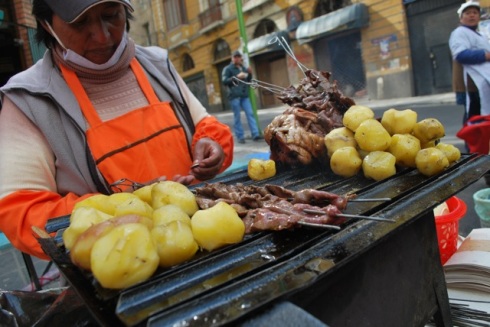
Buying yet more anticuchos (cow heart skewers), La Paz. Served with potato and spicy peanut sauce, yum!
It is a city fiercely proud of its indigenous roots, outwardly brash but ultimately friendly, a city on the rise, that’s set in an unrivaled location. A city whose citizens are alert, active, civic-minded, never letting a politician, corporation or fraudster away with anything – a blockade is a frequent occurrence somewhere around the city. It is a city that likes to eat, dance and celebrate – there is a colourful fiesta for everything. It is a city which gets under your skin and a city in which we made some wonderful, lifelong friends – and that’s rare for those always on the move.
In our six months there we tried to sample a bit of (almost) everything on offer – from the chaos of the El Alto market – set in the militant, self-organised, sprawling section of the city perched high on the altiplano overlooking central La Paz – where we picked up boots and a shirt for next to nothing – to Paula’s death-defying mountain-bike jaunt down the world’s most dangerous road, from a night at a local peña (folk music drinking dens) with fellow comrades Tristan and Bianca, to enjoying the crazy day-long dancing spectacle which is Gran Poder – the year’s biggest celebration of Paceña culture and a growing symbol of the inexorable rise of the Aymara influence in the city.
But it was the day-to-day vibe of the city that also grabbed us – socialising, going to football, hiking, shopping, filling up on tasty street food and just chatting to friends. We even rose to the challenge of getting new glasses, medical check ups and doing some paying journalism work. All very normal in a city which is anything but ordinary.
But for us, La Paz will always be associated with our time in Jupapina with Emma, Rolando and their kids David and Bell and the animals. They have been so hospitable, such good friends who offered us advice, did us endless favours and make a mean Chuflay – a Bolivian gin and tonic!
No sooner had we arrived back in La Paz than Rolando said he had a job for us. He was thinking of selling an artesanal local beer in their campsite shop and he wanted us to visit the brewery with him to taste it. Five hours later we crawled home.
To help repay them a little we house-sat for them when they had a rare few days away, worked on the campsite reception and even took their three dogs for a walk. Emma’s parting words when they set off were not to try and walk the three of them at once – take it in turns. Bah! How hard could it be? After a titanic struggle with three of us trying to get the lead on two of the dogs while the third one head-butted the door, angry at being left out, we caved. All three it is then. We were dragged at high speed to the river in the valley below, then hauled through the water while they frolicked in the mud. Ooops. Lesson learned.
But it wasn’t just the two of us that had a variety of experiences in La Paz – the van, inevitably, did too. At 4100m above sea level, as we approached the longed-for comfort of Emma and Rolando’s beautiful place in the valley of the flowers – and the amazing campsite we had worked on during our last visit to La Paz – we had our first puncture in 3 years. Also during our stay the van’s electrics went haywire and the battery died.
It had always been the plan to get the van checked out thoroughly at Volksmotor, a now famous VW workshop which has become a must-visit for all overlanders. Swiss-trained mechanic Ernesto Hug went over things with a fine toothcomb, presenting us with a (thankfully) minor list of routine things that needed replacing. With me heading back to the UK for a flying visit to see my parents it was the perfect opportunity to get those hard-to-find spares. I was stopped at customs twice on my return to ask what a tie rod end was for, or why I had brake caliper seal kits in my hand luggage – oh, and did I really need that much sandwich pickle, thai curry paste and tea bags? The answer, of course, was yes.
The friendships we made in La Paz have travelled with us. During some of the many, many barbeques we had at Emma and Rolando’s, we met the parents of another friend of ours, Anahi. Luis and Ellie live in Cochabamba – smack bang in the heart of the country’s richest agricultural region – and kindly extended an invitation to show us the gastronomic delights of the city, whose inhabitants claim they ‘don’t eat to live but live to eat’. They aren’t wrong. No sooner had we, with some difficulty, parked our 17ft van in their 17ft-long garage than we were sat in a shady courtyard enjoying plates of boiled and fried guinea pig, dried strips of beef charque, stuffed locoto peppers, mote with cheese, roasted duckling and a couple of local beers.
Next day, after a couple of mid-morning snacks at the local market, we tried what we were told was the best chicharron – fried pork – in the world. It’s a lofty claim but having tasted the most succulent pork ever, we really cannot argue. A walk up to Cochabamba’s ‘Christ the Redeemer statue’ – well, actually, we drove almost all of the way – hardly made a dent in the weight we put on in just a long weekend with such generous hosts.
When we left La Paz last year we left some bags of clothes and other things behind, knowing it gave us the ideal excuse for coming back. This time we just (accidentally) left our beloved lime squeezer – I’m not sure that alone would be enough to bring us back, but everything else La Paz has to offer may well do the job one day.
Days: 1,044
Miles: 22,724
Things we now know to be true: Nowhere´s perfect.

